How to Determine Acceptable Weld Quality

Certain industries that involve welding of their products have very strict quality standards to ensure the production of sound welds. Many others however, do not. They simply weld and unless one of their products fails they don’t pay special attention to welding procedures, detailed inspection of welds or testing the skill (performance) of their welders. […]







